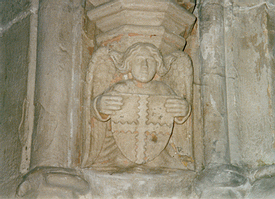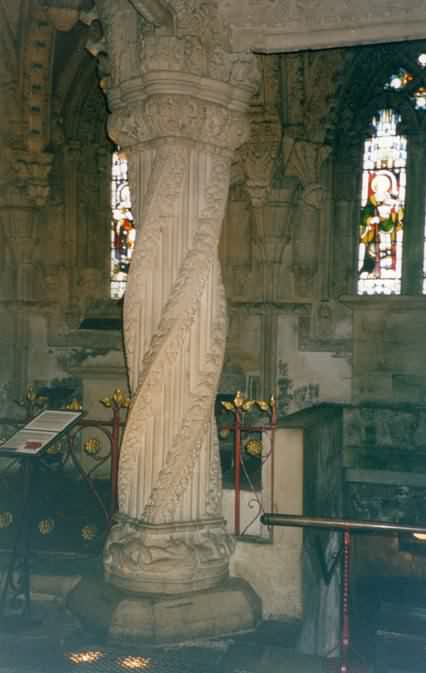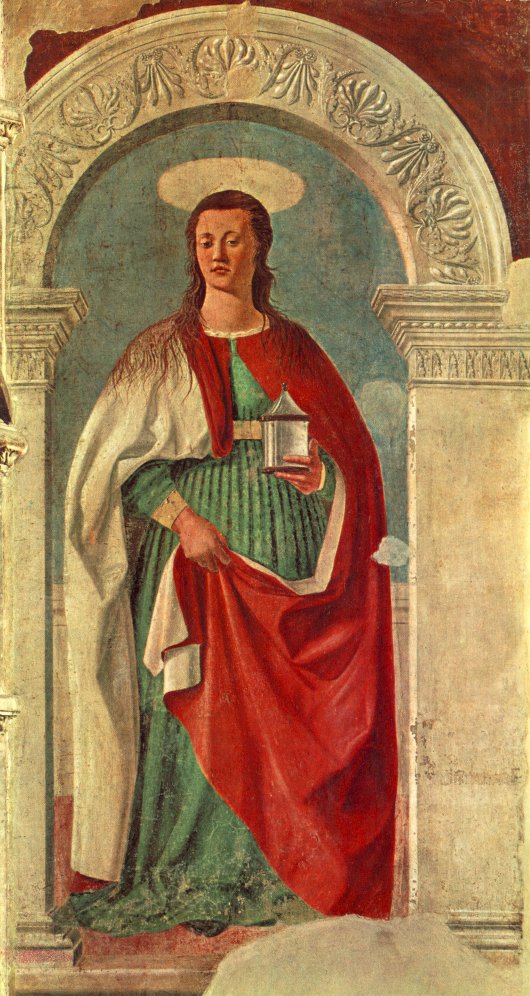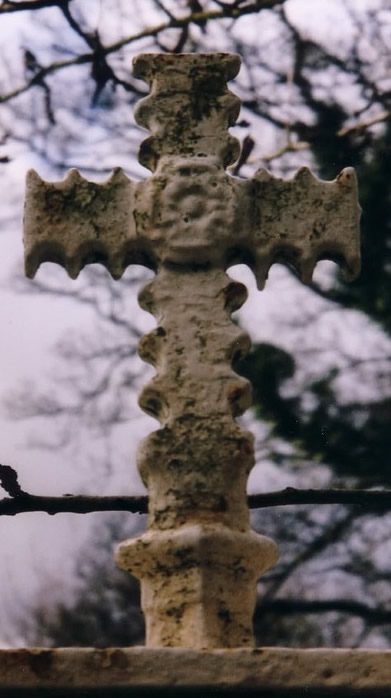Sacred Connections Scotland
Rosa Templum: The enigmatic arcanum of Rosslyn Chapel
Barry Dunford

The engrailed cross of the Clan Sinclair in Rosslyn Chapel
Could the following line of research provide a key to unlocking the historical mystery and conundrum surrounding the most famed chapel in Scotland?
One of the telluric ley lines traversing Scotland has been named the “Rose Line” which may pass through the Masonic Templar Chapel at Roslin (Rose Line?), located a few miles south of Edinburgh. This Chapel is a Templar Mausoleum for the Sinclair (originally St. Clair) family whom it has been alleged are descended from what has been referred to as the Jesus Holy Bloodline. A 19th century writer, W. F. C. Wigston, describes Rosslyn Chapel as “a Masonic Temple…. the cradle of Scotch Masonry, if not of something deeper still.” Writing about the symbolism of the Chapel, Wigston refers to the rose on the keystone of the east window, and he goes on to say: “The predominant ornaments are the Fleur-de-Lis, the Rose, and the Sunflower. Upon the roof of the aisles is the engrailed cross of the founders, St. Clairs, once hereditary Grand Masters of Scotch Masonry.” (Bacon Shakespeare and the Rosicrucians, 1888).
In Medieval times Jesus’ mother was known as Santa Maria della Rosa, and according to a 19th century antiquary, Godfrey Higgins, in his magnum opus Anacalypsis Vol. II, 1836: “Jesus was called the Rose – the rose of Sharon”. This may suggest that Jesus was of a rose lineage, hence a possible genealogical connection with the Clan St. Clair of Roslin – Roseline? It is interesting to note from the signature of Sir William Sinclair, a former Earl of Rosslyn, that he signed his name St. Clair of Roselin. Sir William Sinclair (St. Clair) was referred to as the “last of the Roslins” and his death in 1778 terminated “the lordly line of high St. Clair.” Furthermore, ancient Scottish charters were witnessed by a certain Roger de Roselyn (my italics BD).
In 1863, a Victorian clergyman, the Rev. Edward Bradley (1827-89), when writing about Rosslyn Chapel, under the pen name of Cuthbert Bede, observed: “The only repetition in the ornamentation of the building is with the rose (as though the word was derived from Rose-lin); the sculptured roses are prodigally scattered over the building, both outside and in.” (A Tour in Tartan-Land).
The foregoing is epitomised in the dirge of Rosabelle by Sir Walter Scott from his The Lay of the Last Minstrel:
Blazed battlement and pinnet high,
Blazed every rose-carved buttress fair –
So still they blaze, when fate is nigh
The lordly line of high St. Clair
Rosslyn Chapel has been described as a veritable “Church of the Holy Grail”. It has also been likened to a Hindu temple. (Ref. Rosslyn: The Chapel, Castle and Scenic Lore by Will Grant, F. S. A., Scot., 1947). Moreover, Rosslyn Chapel’s past association with craft guilds, knights templar, rosicrucians and freemasons has become legendary. As far back as 1722, Alexander Nisbet in his System of Heraldry (vol. II) writes of Rosslyn Chapel: “This collegiate church is a noble and magnificent structure of Gothic architecture, enriched both within and without with great variety of ornaments suitable to that order, and beautified in several places with histories, emblems and other figures, curiously represented in bas-relief, which yet discover that they have been handsomely guilded and painted. The fabric in general has always been looked upon as a master-piece in its kind, and is still esteemed as such by very good judges of architecture, and upon that account is frequently resorted to by the curious, as well natives as foreigners, who view it with pleasure and satisfaction.” More recently, Thupton Tushi, the Dalai Lama’s archivist, described his visit to Rosslyn Chapel as “a truly spiritual experience”. Clearly this Scottish Chapel’s intriguing archaic symbolism, which appears to be multi-faceted and multi-layered, has served to stir the consciousness of many people who have been drawn into its arcane precinct over a number of centuries.
Regarding the claim that Rosslyn Chapel is a grail church, Walter Johannes Stein (a friend and pupil of the Austrian mystic Rudolf Steiner) has observed: “There are two spiritual traditions which found each other and united in Rosslyn Chapel. These two traditions appear also in the history of the Holy Grail. Both of them deal with the secrets of Christianity; but one deals with the subject from the macrocosmic point of view, the other from the microcosmic aspect.. That these two traditions have united in Rosslyn Chapel can be seen in the symbols there used, which indicate both paths: how man can strive to become Divine, and how the Divine became flesh. Christ as the corner stone of cosmic and human evolution is shown in the Chapel. Statues in this chapel are situated in such a way that those portraying certain events of the Old Testament are placed opposite to statues portraying events in the New Testament. These statues are connected by garlands. If we take the Bible and read through it in the way the garland leads from one quotation to the next, we shall see that the Old Testament shows how the cosmic force, the Logos, came down to earth, step by step. Reading in the same way through the New Testament, we can see how man is taken back to heaven, again, step by step. The corresponding stages of the way down and the way up are placed opposite to each other in this building. The master who built the Chapel has conveyed many secrets of evolution to those who study, not only what is portrayed, but also how it is portrayed.” (The British: Their Psychology and Destiny, 1958).
In 1446 the building of Rosslyn Chapel was commenced as a Collegiate Church, but it was never completed due to the death of its founder, Sir William St. Clair, in 1484. It was originally intended to be a much larger cruciform building with a tower at its centre. In his Theatrum Scotiae (1693), John Slezer states that the chief pillar in Rosslyn Chapel was originally called the ‘Prince’s Pillar’ after Sir William St. Clair, Prince of Orkney. Later, the Prince’s Pillar became known as the ‘Apprentice Pillar’. The Rev. Edward Bradley notes: “Perhaps those who handed down this tradition improved it by grafting upon it the popular story of the murdered workman, and changing ‘Prince’ into ‘Prentice.’ Others have imagined that it was called the Prince’s (or Prince) Pillar merely because it was the chief pillar. It may be asked, Why should this column be made so superior to the others, when it has not a central situation-for it is the end pillar out of three? .. it is the nearest pillar to the high altar of the Virgin. This altar is raised two steps above the floor; and underneath it is the flight of twenty-two steps leading down to a building erected eastward of the Chapel.. This building is variously called by the names of chapel, crypt, sacristy, or vestry.” (A Tour in Tartan-Land, 1863).
Curiously, twenty-two ‘mason-marks’ are to be found on the stonework of Rosslyn Chapel, and twenty-two is also the number of the Greater Arcana (the Great Secrets) of the Tarot, which in turn may relate to the twenty-two letters of the cabalistic Hebrew alphabet. Could this suggest twenty-two steps of initiation? This notion is supported by Basil Ivan Rakoczi, who states: “The Gypsy Master teaches that the Greater Arcana or Trumps Major of the Tarot represent the twenty-two steps upon the way of Initiation.” (The Painted Caravan: Penetration into the Secrets of the Tarot Cards, 1954). Further, commenting on the trumps card in the Tarot, an American researcher, Margaret Starbird, writes: “It was these trumps that in the original decks illustrated the actual tenets and history of the hidden Church of the Grail.” (The Woman with the Alabastar Jar, 1993)
In The Painted Caravan, Rakoczi further relates: “But what is this word, Tarot? Is its root to be found in the name of the Tinker’s secret language, the Shelta Thari, which was discovered by Charles Godfrey Leland and was, after much scholarly research by George Sampson, proved to be a Q-Celtic language; for, though the Tinker is decried by his brother Gypsy, he is, it is now thought, a descendent of ancient dispossessed land owners, the Picts, who, in turn, had inter-married with Phoenicians and had equally their roots (perhaps intertwined with those of the Gypsies) in the Orient?”
In the light of this possible pictish association it may be pertinent to note that according to the researches of Father Richard Hay (1661 – c. 1736), the Rosslyn historian, the original founding of the site known as Roslin was by a Pict named Asterius about the end of the 2nd century A. D. Asterius would most likely have been a member of the Pictish royal lineage, and his daughter Panthioria, almost certainly a Pictish Princess, married the Scots king Donaldus (reigned 199-216 A. D) who, according to the old Scots Chronicles, was the first Christian Scottish King. In John Monipennie’s summary of the ancient Scots Chronicles, first published in 1612, is a reference to “Donaldus Primus, the first Christian king of Scotland.. This king Donaldus coined gold and silver, and embraced the Christian faith.” It seems likely that Panthioria may also have embraced the Christian faith at that time. Prior to the reign of Donaldus Primus several Scottish kings had married women from the Pictish royal lineage some of whom were daughters of Pictish kings. So there is good reason to suppose that King Donaldus would have married into the Pictish royal lineage.
There was a strong gypsy presence at Roslin during the Middle Ages under the patronage of the St. Clair (Sinclair) family. The gypsies were called “Egyptians” and, like the Celtic Gael, they were credited with psychic abilities or ‘second sight’, which the Australian aboriginals call ‘sacred sight’. According to Basil Ivan Rakoczi: “The fact is that the Gypsies have wandered from the beginning of time and the gift of clairvoyance has always been theirs. They did not steal the esoteric wisdom of the Tarot in Egypt or anywhere else. Rather, as one civilisation after another fell and, later, as the pagan cults became the object of Christian persecution, their dying priesthoods deposited the sacred lore in the hands of the Gypsies who undertook to travel on with it, to hide it and only to transmit it to the trustworthy. Who would suspect a mere Gypsy of possessing the accumulated wisdom of Chaldea and Egypt, or of the northern Druids, or of holding the Yoga teachings of the East in his head? So the Gypsy tribes became the repositories for all that wisdom which was denounced as heretical by the established order of the day. The Gypsy took over the wisdom of the Gnostic, the Montanist, the Donatist and the Manichean, ascending the heresiarchical ladder of experimental mysticism to mediaeval sects such as the Cathars, the Patarini and the Bogomils who, in turn, produced the creed which threatened to change completely the whole face of Europe.” (The Painted Caravan). If such arcane knowledge was held within the gypsy tribes, then perhaps the St. Clairs of Roslin were drawing upon this for their own esoteric purposes and agenda; hence their especial patronage to large numbers of gypsies living in Roslin Glen.
Bearing in mind the templar, rosicrucian and masonic ramifications surrounding the Clan St. Clair and Rosslyn Chapel, a curious early historical reference to a rosicrucian and masonic tradition in Scotland appeared in an unusual poem by Henry Adamson, the metrical historian of Perth (formerly the ancient Capital of Scotland), entitled Muses Threnodie which was published in Edinburgh in 1638. Within this poem three intriguing lines appear to link together a rosicrucian fraternity, a masonic tradition and, like the gypsies, a psychic ability to foretell the future:
For we be brethren of the Rosie Crosse;
We have the Mason word, and second sight,
Things for to come we can foretell aright.
The Scottish Rosicrucian connection is also of interest to note. According to an esoteric tradition the Brotherhood of the Rosy Cross was said to have been founded in the 15th century by an alchemical adept known as Christian Rosenkreutz (Rosy Cross). This mystical adept was a contemporary of Sir William St. Clair, founder of Rosslyn Chapel, and rather synchronistically they both died in 1484. Furthermore, they were both members of a chivalric knighthood called the Order of the Golden Fleece. What is clear is that all manner of intriguing historical facets appear to interface with the enigmatic place called Roslin.
Returning to the popularly known Apprentice Pillar, originally called the ‘Prince’ pillar, it may be open to speculation that its counterpart pillar (of a row of three) which is usually referred to as the ‘Master Mason Pillar’, could actually be the ‘Princess’ pillar. If this is so then what might the central pillar symbolically represent? Could this trinitarian array of pillars be conveying a generic or genealogical message? That is to say a royal bloodline or lineage descending from a royal prince and princess. If this is the case then who might they be?
It is claimed that the so-called Apprentice Pillar and its counterpart known as the Master Mason’s Pillar form a twin pillar symbolism as in the Jachin and Boaz Solomonic Masonic tradition. It has also been alluded that they may in some way symbolise the twin pillars of Enoch. However, these theories discount the supremely important presence of a central pillar thus revealing a trinitarian, rather than a dualistic, symbolic representation.

The Apprentice Pillar orginally called the Prince Pillar
Along with a profuse display of roses and rosettes in Rosslyn Chapel there is also a prolific portrayal of the vine chiselled into the stone work. In the mystical and metaphysical Gospel of St. John, Jesus is recorded as saying: “I am the true vine”. According to Dr. Neil Douglas-Klotz, an Aramaic scholar: “The word for ‘vine’ comes from the verb meaning to dig, or form a body from. Metaphorically, it can be used in Hebrew or Aramaic to refer to a blood lineage.” (The Hidden Gospel: Decoding the Spiritual Message of the Aramaic Jesus, 1999).
In the Canon of the New Testament, it is said that Jesus was descended from the Davidic royal lineage. Could it be that the ‘Prince’ pillar at Rosslyn Chapel symbolises Christ Jesus and a royal rose lineage of the true vine of Christic descent? Bearing in mind the esoteric tradition that a holy bloodline issued from a holy union between Jesus and Mary Magdalene, also said to be of royal descent, then might the speculative ‘Princess’ pillar represent Mary Magdalene? If this is the case then the central pillar (usually referred to as the Journeyman’s pillar) could represent a continuation of the Christic rose lineage, thus this might be referred to as the ‘Rose’ pillar. Interestingly, a line from a poem by one of the old welsh bards reads: “Christ the Concealed, pillar of peace” (ref. Cyclops Christianus by Algernon Herbert, 1849).
Based on an extensive study of history, heraldry, symbolism, medieval art, mythology, psychology and the Bible itself, Margaret Starbird, a Roman Catholic scholar, in her seminal work The Woman with the Alabastar Jar: Mary Magdalene and the Holy Grail, writes: “I believe that it was the spread of the heresy of the Holy Grail that caused this surprising transformation of Mary Magdalene from prostitute to Sister-Bride in artistic representations during the twelfth century. The Mary depicted in many of these medieval paintings was not a ‘repentant sinner’ or a ‘reformed prostitute’, nor was she merely a friend of Jesus. She was his beloved.” It may be of interest to note that Mary Magdalene is revered in Provence, France (ancient Gaul) as “the Saint Apostle of Provence” thus elevating her to an apostolic status. In this same work, Margaret Starbird states that Provence: “.. had been the centre of a cult of Mary Magdalene for centuries, as witness the numerous chapels, fountains, springs, and other geographical landmarks in the region that bear her name. She was the patron saint of gardens and vineyards throughout the region.. It was not accidental that the cult of the Rose (an anagram of Eros) flourished and bloomed in the garden of Provence.” She further remarks: “The idiom ‘under the sign of the rose’ actually meant something specific for the initiated. For them.. the secret is the rose – the red rose of the other Mary, the Mary who represents Eros, the passionate bridal aspect of the feminine, which was denied by the established church.”
In the Magdalene College Library at Oxford, there is a remarkable old manuscript Life of St. Mary Magdalene (no. 89 in the Library Catalogue). This manuscript professes to be the copy of an original Life of St. Mary Magdalene compiled by Rabanus Maurus, Archbishop of Mayence, (776-856). This work, which is a Life not only of St. Mary Magdalene, but also of her sister St. Martha, is divided into fifty chapters and preceded by a Prologus or ‘Preface’. This Prologus begins: “The contemplative life of the most blessed Mary Magdalene, named with the highest reverence as the sweetest chosen of Christ, and by Christ greatly beloved.” (ref. The Coming of the Saints by John W. Taylor, 1906). This special relationship between Jesus and Mary Magdalene is further supported in the early gnostic christian texts discovered at Nag Hammadi in upper Egypt in 1945. “There were three who always walked with the lord: Mary his mother and her sister and Magdalene, the one who was called his companion. His sister and his mother and his companion were each a Mary” (The Gospel of Philip). Moreover, in The Gospel of Mary (Magdalene), St. Peter is recorded as saying to Mary Magdalene: “Sister, we know that the Savior loved you more than the rest of women.” When there were apparently a number of women in the circle around Jesus why should Mary Magdalene have been singled out in such a manner. What underlined the specific distinction about the relationship between Jesus and Mary Magdalene which is made plain in these early christian sources?
Rather curiously, a very old tradition which appears to have originated in the Scottish Highlands and Islands refers to a St. Bride as being the “foster-mother of Christ”. She is also called “Mary of the Gael”. So clearly St. Bride in the Hebridean mythos was named Mary. However, why should she have been given the unusual appellation of “foster-mother of Christ”, particularly when it is generally believed that Mary, the mother of Christ, survived her son after his resurrection and ascension. Could the gaelic term “foster mother” have another connotation in this particular instance? Surely the key to the root of this matter must lie with a specific Mary being a Holy (Saint) BRIDE, who is also identified as being directly associated with Christ Jesus? The term Bride has a clear definition of relating to a state of marriage or marital union. So is this old Hebridean mythos indicating that Jesus and Mary Magdalene may have been married?
Remarkably, in a fresco painting in Arezzo Cathedral, Italy, by Piero della Francesca (1416-92), Mary Magdalene appears to be portrayed as being pregnant:

St. Mary Magdalene by Piero della Francesca Fresco (1460) in Arezzo Cathedral, Italy
In a West Highland incantation from the Carmina Gadelica (vol. I) occur the intriguing lines:
It was Bride the fair who went on her knee,
It is the King of Glory who is in her lap.
Christ the Priest above us.
Could the phrase referring to “Bride the fair who went on her knee” be indicative of Mary Magdalene anointing the feet of Jesus?
Throughout the Hebridean western isles in particular, and the mainland of Scotland in general, there are many religious sites dedicated to St. Bride (not to be confused with the later St. Bridget of Kildare, Ireland). However, there are apparently no religious dedications to Mary Magdalene throughout the Hebrides and the western seaboard of Scotland. This is rather unusual when other leading personalities around Jesus, as well as Christ himself, are venerated in numerous chapels and churches throughout this region of Scotland. There was certainly no antagonism towards Mary Magdalene in the early celtic christian mythos. Could the simple explanation for this omission be due to the fact that the gaelic people of the Hebrides and the West Highlands knew of Mary Magdalene as the Holy (Saint) Bride of Christ? How else can one account for this curious anomaly? Bearing in mind the statement that Mary Magdalene was a constant companion of Jesus and also information which suggests that Jesus may have visited the western isles of Scotland; (Did Jesus visit Scotland?) it would be perfectly conceivable that Mary Magdalene could also have visited the remote western isles of Scotland, hence the oral tradition there relating to a specific Holy (Saint) Bride, who was also identified as the “foster-mother of Christ”.
Returning to Rosslyn Chapel, until 1835 the Master Mason (Princess?) pillar had been plastered over. It was only when the plaster was removed that its overlaid symbolic carvings were revealed. Why was there a deliberate attempt to conceal this? Considering the elaborate designs sculptured on the two adjacent pillars, why then should the key central pillar ostensibly be left blank? Is it conceivable that the currently plain central pillar may also have been plastered over? If so, then why and what might it conceal? Could the primary focus of attention, which has been directed towards the elaborately carved apprentice (prince) pillar, have been engineered as a decoy?

Sinclair engrailed cross overlaid with a rose
As already mentioned, during the Middle Ages the mother of Jesus was known as Santa Maria della Rosa and esoterically Jesus has been referred to as the Rose. Moreover, Mary Magdalene has also been identified with the Rose symbolism, as well as perhaps being married to Jesus. It has been suggested that the Clan St. Clair (Sinclair) may be descended from the Jesus holy bloodline i. e. a Rose line or lineage, the ‘true vine’. Was it a knowledge of this which prompted Sir William St. Clair to perhaps construct a church at Roslin (Rose Line) as a Temple of the Rose (Rosa Templum), a sacred memorial and testament to this genealogical Christic grail streaming? Curiously, during the 19th century the fourth Earl of Rosslyn placed railings round the Chapel, which were surmounted by the St. Clair heraldic engrailed cross with a rose overlaid at the point of intersection. This is symbolic of the Crucified Rose or Jesus on the Cross of space/time placed at the centre now point of eternality and immortality. “As it was in the beginning, is now, and forever shall be, world without end.” – AMEN. Moreover, as a Scots engineer, C. H. Douglas, perceptively observed: “Life is a cross-section of eternity”.
It would appear the enigmatic Rosa Templum (Temple of the Rose) possesses a hidden significance which might indeed be described as being sub rosa, i. e. concealed under the Rose.